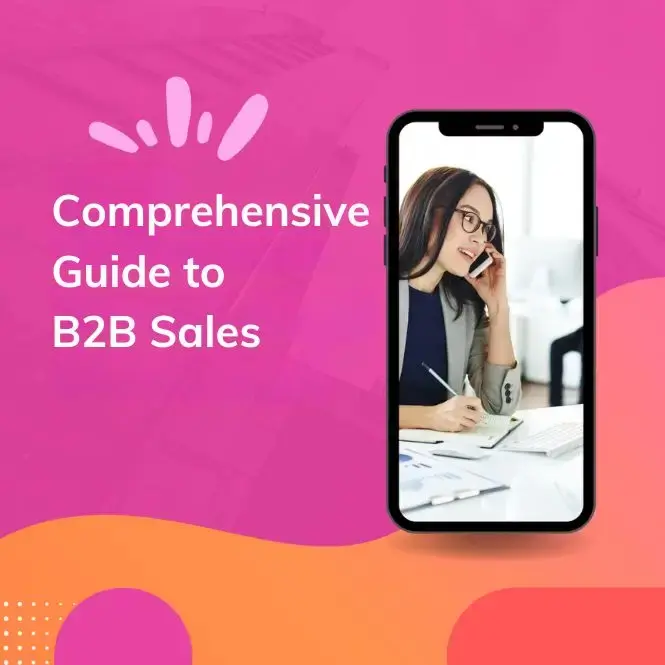1 min read
A Comprehensive Guide to B2B Sales
To run your B2B business effectively, expand it and ensure its longevity, it's essential to take control of your lead generation and sales activities.
9 min read
Peter
:
Oct 29, 2024 2:14:21 PM

Discover a powerful technique to skyrocket your Big Deal and Enterprise Sales by mastering the art of running a successful Proof of Value (POV).
In the high-stakes arena of enterprise sales, promises alone no longer suffice. Decision-makers demand concrete evidence that a solution will deliver tangible benefits.
Enter the Proof of Value (PoV) - a strategic approach that not only demonstrates your product's capabilities but also quantifies its impact within the client's environment.
By aligning your solution with the client's specific objectives and showcasing measurable outcomes, a well-executed PoV transforms skepticism into confidence, paving the way for successful, long-term partnerships
Contents
Understanding Proof of Value - the key to customer trust
What is the difference between POC and POV?
What are the benefits of running a POV?
Steps to implementing Proof of Value in your Sales Strategy
What are the top PoV Best Practices?
How to Measure Value from a PoV
How to Prepare Before Offering a PoV
Three crucial B2B buying criteria are:
1. Show me it is working
2. Tell me who else is using it and
3. What is the ROI?
In fact, studies show that 63% of buyers expect companies to provide detailed proof of ROI before making a purchasing decision [DemandGen].
A well-structured POV helps showcase your solution's unique strengths and validates its long term benefits for your customer's business.
Let’s explore how PoV works, its benefits and actionable tips for implementing it successfully in your sales process.
tune in to our "POV Deep Dive" Podcast
Proof of Value is a structured, evidence-based demonstration of the tangible benefits of your solution, partially deployed into the customer's environment.
It highlights ROI, usability and overall impact within a buyer’s context. Think of it as a mini-experiment: you’re selling an idea and proving the investment with quantifiable results.
Proof of Value (PoV) is a pragmatic approach where businesses demonstrate the tangible benefits and effectiveness of their solutions to potential customers.
Complementing traditional sales tactics that rely heavily on promises and theoretical benefits, PoVs provide concrete evidence that the solution works as claimed for the specific customer use case.
This evidence can take various forms, such as pilot implementation (desktop and live), demonstrations, testimonials, site visits, case studies and data mining for performance metrics.
Establishing a PoV builds confidence and trust. When prospects see real-world examples of how your solution successfully addresses similar challenges and when they see it operating in their own business, their confidence in your offering dramatically increases.
This trust is foundational for converting leads into loyal customers, as it mitigates the implementation risks associated with buying and implementing a new solution.
While Proof of Concept (PoC) is all about testing and ultimately proving the feasibility of a solution, a Proof of Value (PoV) focuses on measuring the business benefits of the solution.
PoC shows whether the solution works; PoV shows why it matters.
This shift makes PoV essential for decision-makers who want ROI proof rather than just functionality.

Here are the five steps to using a PoV in your sales motion:
1. Identify Key Metrics: Determine the specific metrics that will most effectively demonstrate the value of your solution. These could include cost savings, simplification of process, efficiency improvements, revenue growth, or increased customer satisfaction scores.
2. Develop Case Studies: Create detailed case studies that highlight successful implementations of your solution. Include qualitative and quantitative data to view your customers' benefits comprehensively.
3. Offer to run PoV: Provide potential customers with the opportunity to trial your solution on a small well-defined scale. This allows them to see firsthand how it can address their unique challenges and deliver measurable results. It's important to ring-fence the PoV to only a handful of key metrics - ideally one key metric. PoVs that are not well-defined and project-managed can result in a lost sale so it pays to plan and execute with precision.
4. Gather Testimonials: Collect and share testimonials from satisfied customers. These endorsements can be powerful tools for building credibility and persuading prospects of your solution's value.
5. Utilise Data and Analytics: Leverage data analytics to track and present your solution's performance. Visual representations of success metrics can make a compelling case.
.webp?width=756&height=515&name=Proof%20of%20value%20(1).webp)

Value in PoV is measurable through agreed metrics and Key Performance Indicators (KPIs). Examples include;
Measure these metrics against your baseline to demonstrate a tangible difference. Use both quantitative data, like financial metrics and qualitative feedback, like employee testimonials to paint a comprehensive picture of the value delivered.
Preparation for a PoV involves several steps:
To secure alignment, have an open discussion with the buyer about what success looks like for them. Communicate your goals, establish mutual objectives and clarify each step of the process. The best practice is to charge for the PoV, define the price, timeframe and next steps in the sales cycle.
By setting a shared vision of success, you ensure a collaborative POV in which both sides understand their roles and expected outcomes and you have visibility into the deal's closing and negotiation steps.
In many cases, getting the PoV approved will mimic the actual sales process and give you a chance to meet key stakeholders.
Success in PoV depends on collaboration, continuous feedback and a shared understanding of what success looks like and the next steps.
Conduct regular stand-ups with your customer to promptly address concerns and adjust the PoV as needed.
Keep communication open, document progress and be ready to showcase incremental wins.
This transparency not only builds trust but also allows for real-time adjustments that ensure the PoV stays on track.
 One common pitfall is failing to be explicit about what a successful PoV looks like for each customer.
One common pitfall is failing to be explicit about what a successful PoV looks like for each customer.
It's essential to tailor your PoV outcomes to address the unique challenges faced by each potential customer. Generic case studies or metrics may not resonate as strongly as those that directly relate to their situation.
Another mistake is overloading prospects with too much information. While it's important to provide comprehensive evidence, overwhelming them with data can be counterproductive.
Focus on the most compelling and relevant points to keep your message clear and impactful.
Additionally, neglecting to follow up after providing a PoV can diminish its effectiveness. Ensure that you maintain communication with the prospect, address any questions or concerns they may have and reinforce the demonstrated value throughout the sales process.
To gauge the effectiveness of your PoV strategy, track key performance indicators (KPIs) such as conversion rates, sales cycle length and customer acquisition costs.
An increase in conversion rates and a reduction in sales cycle length are strong indicators that your PoV efforts are resonating with prospects.
Customer feedback is another valuable metric. Conduct surveys or solicit testimonials to understand how the PoV influenced their decision-making process. This feedback can provide insights into areas for improvement and help refine your approach.
Additionally, analyse the performance of different PoV elements, such as case studies, pilot programs and testimonials to determine which are most effective in driving sales. Use this data to optimise your strategy and focus on the tactics that yield the highest returns.
 The ultimate goal is to transition from PoV to a signed contract and this path should be established as part of the PoV scope.
The ultimate goal is to transition from PoV to a signed contract and this path should be established as part of the PoV scope.
Presenting the results and focusing on how you met the key metric should trigger a redefined set of actions, meetings and documentation.
Address any final concerns and outline the next steps for implementation. A well-prepared presentation, coupled with the PoV’s evidence of value, increases the likelihood of securing the sale.
We use PoVs as part of our sales process, especially for our larger Enterprise customers.
An example is our customer, Hunter Apparel Solutions. We implemented a PoV to demonstrate how Service Hub's Help Desk and Ticketing function would reduce Customer Service ticket resolution time and improve service.
Click here to read our case study showcasing how successful it was.
Indeed, while a PoV may be a critical component of a successful sale for many businesses, it is essential to also consider other factors such as;
Embracing omnichannel outreach
Embracing next generation sales technology
Embracing data analytics
Initially, we collaborate with you to formulate strategies grounded in deep customer insights. This approach enables the best comprehension of customer challenges and the identification of true customer value and flushes out missed opportunities, like cross-sell and upsell programs or contracted price increases etc.
Advanced analytics play a pivotal role in this process, providing insights into factors like buying propensity and churn rates. These insights enhance the company's understanding of how to evolve its go-to-market strategy and sales processes effectively.
Visit our Sales Consulting and POV services pages to learn more
HubSpot Smart CRM - your Single Source of Truth
Industry-leading sales and marketing data and analytics tools harness a comprehensive range of internal and external data types and sources. To maintain consistent and reliable outputs, organisations are encouraged to establish a centralised data repository, serving as a "single source of truth."
This approach enhances accessibility for multiple users and systems, thereby improving efficiency and fostering collaboration. Additionally, a centralised repository simplifies backup processes, data management, and maintenance, while minimising data errors and bolstering security.
Contrary to the belief that perfect data is a prerequisite, meaningful progress can be achieved through a use case-based strategy. This involves identifying the most promising use cases and rapidly scaling data across these scenarios through efficient testing.
The end goal is ultimately to drive sustainable business growth by aligning sales, marketing and customer service on one user-friendly, widely-adopted, integrated platform.
Proof of Value (PoV) is a confident and powerful closing mechanism suitable for many B2B Sales teams.
The significant advantage of a Proof of Value lies in its ability to not only meet technical specifications but also to construct a compelling business case for investment from the client's perspective.
In the hands of a skilled salesperson, a POV can be used to navigate the customer's decision-making unit (DMU), discover the formal and informal decision criteria and qualify the politics to win the deal.
A PoV showcases your product’s potential to stakeholders, accelerates the decision-making process and sets a foundation for a strong client relationship. By understanding the value of PoV and using it strategically, you’re not just selling a solution - you’re providing undeniable proof that it’s the right choice!
The ideal case is that the PoV accelerates the sale.
Within that context, a PoV should take no more than 25 percent of the time it takes to nurture a deal to close.
In the absence of this relative measure, a PoV generally runs for 3-4 weeks; depending on the complexity of the solution, it may take longer.
Not necessarily; PoVs are most beneficial for high-stakes or complex sales where there is a relative competitive advantage to be had from demonstrating one quick win metric.
Unlike free trials, a PoV is usually NOT free, as they are most valuable in complex sales across multiple departments. They usually involve specialist resources, and customers do not value what they don't pay for—hence the fee.
PoVs are structured with measurable objectives and a focus on demonstrating value.
Yes,
PoVs work extremely well usually associated with upsells and cross-sells in renewal.
PoVs can be an expensive pre-sale cost. We would always recommend that PoVs have a cost to the customer.
The cost can subsequently be offset against the main sale, but ultimately, finding the customer budget for the PoV is time well spent in the account.
Before you go, check Big Business Agency profile on DesignRush!
Related
Sales Playbook - Winning Large Enterprise Deals
Removing Internal Barriers to Growth
Transform your business with cutting edge eCommerce solutions

1 min read
To run your B2B business effectively, expand it and ensure its longevity, it's essential to take control of your lead generation and sales activities.

Companies with “tightly aligned” sales and marketing departments reach 24% faster revenue growth! Yet sales and marketing teams don't always work...

Why consider aligning your Sales Process with the Buyer's Journey? Buyers and sellers may seem like they're from different planets. On one side,...